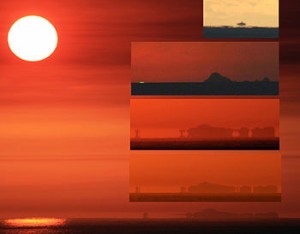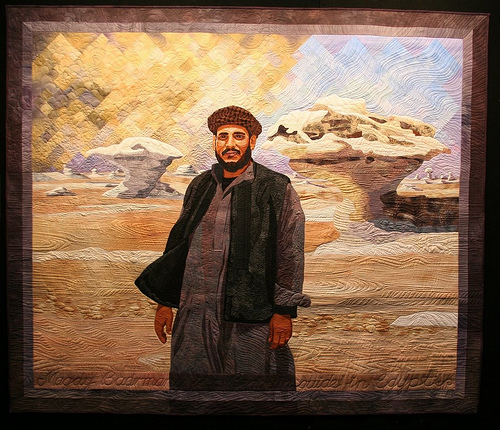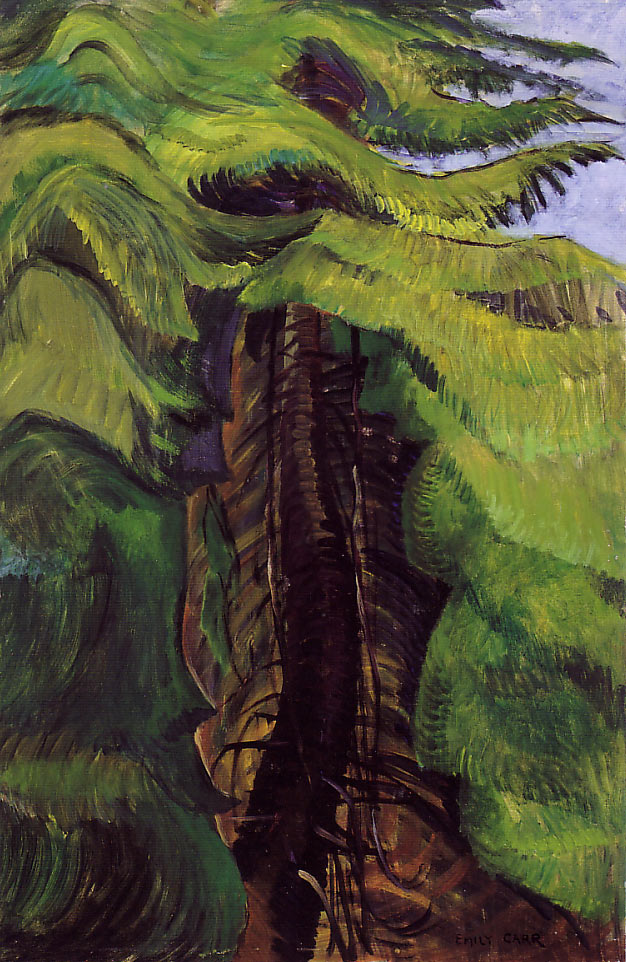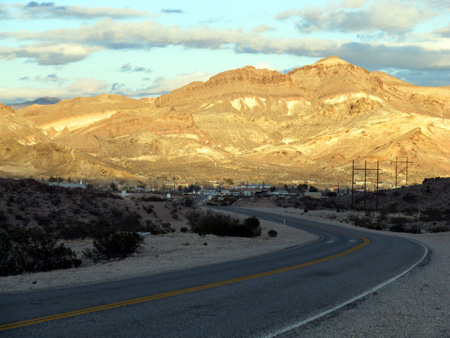Posted by June Underwood on September 4th, 2009

The upper frame is an inferior mirage of the Farallon Islands. The second frame is the Farallon Islands with a green flash on the left-hand side. The two lower frames and the main frame are superior mirages of the Farallon Islands. The superior mirage went from a 3-image mirage (inverted image between erect ones) to a 5-image mirage to 2-image mirage. Such a display is consistent with a Fata Morgana. All frames but the upper one were photographed from about 50–70 feet above sea level. The upper frame was photographed from sea level. The interval between the first and last frames of the superior mirage was six minutes.
And, on a not unrelated subject (albeit obscure, perhaps) I have finished my southeast Oregon painting extravaganza. It resulted in seven panels, each 16″ wide and 12 ” high, a total of 112″ in width (with no spacing) and 12″ in height: 9.25 feet x 1 foot.

[You can see individual panels as well as closer combos by checking southeastmain, a blog I maintain with husband Jer: From the Diamond Grade, panels 1 & 2, and the following four posts are the pertinent material. I’m not bothering to reproduce the results here because many of you already saw them, ad infinitum, on southeastmain.]
more… »
Posted by June Underwood on August 17th, 2009
In a few months, I’ll be back in Nevada, tackling the Amargosa Playa again. This time I want to do a set of painted panels, five 5×5 foot ones (25 horizontal feet). I have various notions of how this might work out in paint, but will have to wait until I get there to see what actually happens. I also want to do something similar in textiles, perhaps only some preliminary image making, saving stitching for when I return to Portland. But I am mulling over both projects in my mind, trying to think how I might work them.
I just read a blog entry (dated August 17) by Jenny Bowker, who is an art colleague who works in quilted textiles. She tackled the same kind of landscape and had the same kind of hopes about what she might evoke, with some additions that the Amargosa doesn’t have: the presence of a handsome driver and some marvelous land forms. Her blog entry, which finishes with the photo of her textile work, is worth reading for sheer pleasure. But it makes me somewhat nervous about my ambitions.
Here’s the photo of Jenny’s artwork, which won a prize at the Canberra quilt exhibit and, I’m sure, will be seen often at other places around the globe.

Jenny Bowker, Sandstorm over the White Desert, about life size (see her blog entry for scale)
And here is an photo or two of what I will be facing, again

more… »
Posted by June Underwood on August 10th, 2009
Some of you already know that I’ve been copying Emily Carr paintings for the last week or so, attempting to understand more fully how she does forests and trees.

Emily Carr, Cedar Sanctuary, 38 x 26″, Oil on paper, 1942
I’ve learned a lot through this exercise [ including the rule that I must paint-over or otherwise destroy the copies I’ve made before someone comes into the studio and exclaims with pleasure over them. Such an exclamation forces me to admit that what the complimenter is seeing is a copy, causing embarassment all round.] Carr’s finding of shapes in the complexity, of making color within the shapes, and of “draping” her branches are all valuable for my own art-making thoughts.
However, during this process, I had other kinds of questions occur.
more… »
Posted by June Underwood on July 26th, 2009
I feel as if I have been away forever. Life overtook my Art and Perception, although not completely my art and not completely all my perceptions.
So here’s an update.
After a long struggle with health and painting, I’ve finally revived and have been painting the landscapes of the Willamette Valley in western Oregon. The change of venue from the wild and awesome desert to the gentle scenery of the Valley was fairly traumatic and also the cause (I think; I hope) of some really bad paintings, now discarded. But I’ve kept a few and think I may be able to tolerate the pretty landscapes and conventional views to which I’ve been subjected. (I’m engaged with a group of plein air artists who always choose not to paint the snarky or sardonic.)
The paintings imaged below have been done since the end of June. The first four (through the Storm) were attempts to provide a sense of expansion outward rather than focusing into the painting. This outward away from the center is what I feel the desert does, and I thought painting sky and/or water might keep me in touch with that expansion of space so essential to desert painting.

Morning Fog in the Gorge, 12 x 16″, Oil on board, 2009
more… »
Posted by June Underwood on May 4th, 2009
A reference to a recent New Yorker Critic at Large (March 30th) review suggests that a work of art is good if it rises out of necessity and if the artist is capable of carrying out the idea to its appropriate end. As a letter writer paraphrases:
“This matters; this has purpose” and “I can do this, I am able, I can carry out this task to its appropriate end” (correspondence from Joachim B. Lyon, Stanford, California, New Yorker, May 4, 2009).
I found these notions both bemusing and contra-indicated. What do you think?
(Oh, and here’s an image from Rhyolite Nevada ghost town. I don’t know if it has either purpose or, if I paint it, as I intend to do, if I am adequate to the chore.)

Posted by June Underwood on April 18th, 2009
As Steve noted not long ago, perception — how, as well as what, we see and record — is prime territory for this group. Some weeks ago I wrote about painting in the desert, the Great Basin to be more precise, and, even more specifically, the Amargosa Plain just outside of Death Valley.
After having spent 6 weeks in the desert, perceiving and painting, mostly plein air, I am now back in Portland reading about desert perception in William L. Fox’s The Void, the Grid, and the Sign.
Fox has spent most of his life in and around a variety of deserts and back-of-nowhere lands, but in The Void he’s primarily concerned with the Great Basin, that large space between the Rockies and the Sierras, where water flows in, but never out, where there is no river coursing to the sea. He says that outside of Afghanistan, this area contains the most mountain ranges (316) in the world, but there are also 90 basins, places where what little water exists is captured between ranges and sinks or evaporates. The best known of these basins is perhaps Death Valley, although that lies outside Fox’s attention. The place I was painting, the Amargosa Plain, is also just outside his wide-ranging travels. However, much of what he says is apropos of the Amargosa and Death Valley.

Death Valley at the Beatty Cut-off, March, 2009
more… »
Posted by June Underwood on March 21st, 2009
And now, at this point (day 30) in this particular residency in Beatty, Nevada, I am pondering a conundrum about my own landscape work. I haven’t quite enough distance to say for certain [pun recognized after it was made] but it seems to me that my interest in context and a sense of place interferes with my achieving a stylistic breakthrough, particularly with the set pieces that I love, like the mountains around Beatty.

As my colleague and friend David T would say: if he walked into a gallery with my landscape paintings, he wouldn’t think of them as being “by June Underwood,”just as “nice” (not a compliment) landscape paintings.

more… »








